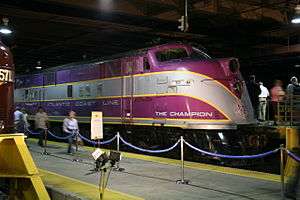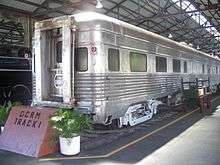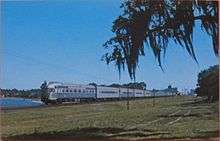Champion (train)
The Champion was a streamlined passenger train operated by the Atlantic Coast Line Railroad and Florida East Coast Railway between New York City and Miami or St. Petersburg, Florida. It operated from 1939 until 1979, continuing under the Seaboard Coast Line and Amtrak. It was a direct competitor to the Seaboard Air Line Railway's Silver Meteor, the first New York-Florida streamliner.
A postcard depiction of the Champion. | |
| Overview | |
|---|---|
| Service type | Inter-city rail |
| Status | discontinued |
| Locale | Northeastern United States/Southeastern United States |
| First service | December 1, 1939 |
| Last service | October 1, 1979 |
| Successor | Silver Meteor |
| Former operator(s) | Atlantic Coast Line (1939–1967) Seaboard Coast Line (1967–1971) Amtrak (1971–1979) |
| Route | |
| Start | New York City |
| End | West Coast section: St. Petersburg East Coast section: Miami |
| Distance travelled | 1,046 miles (1,683 km) |
| Service frequency | Daily |
| Train number(s) | East Coast Champion: 1 (southbound), 2 (northbound) West Coast Champion: 91 (southbound), 92 (northbound) |
| On-board services | |
| Seating arrangements | Reserved coach |
| Sleeping arrangements | Roomettes and double bedrooms |
| Catering facilities | Dining cars |
| Observation facilities | Tavern-lounge cars |
History
Atlantic Coast Line


The Champion started as a daily service of the Atlantic Coast Line Railroad (ACL) in 1939, competing with the Silver Meteor of the Seaboard Air Line (SAL) on the New York–Florida route. Initially just a New York-Miami service, the ACL added a section serving St. Petersburg and the Tampa Bay area in 1941 once enough streamlined equipment was available. The train was rebranded as the Tamiami Champion, with the St. Petersburg section called the Tamiami Champion (West Coast) (91 northbound/92 southbound), and the Miami section called the Tamiami Champion (East Coast) (1 northbound/2 southbound). In 1943 the names became East Coast Champion and West Coast Champion.[1]
Southbound trains originated in New York's Pennsylvania Station, and traveled south over the Pennsylvania Railroad-owned Northeast Corridor through Philadelphia, Pennsylvania to Washington, D.C. There, a radio-equipped lounge car was added to the train. Leaving Washington, trains used the Richmond, Fredericksburg and Potomac Railroad to Richmond, Virginia, the north end of the ACL's main line. From Richmond, trains followed the Atlantic coast through Charleston, South Carolina and Savannah, Georgia to Jacksonville, Florida. Here the train split, with the West Coast section moving south then west through DeLand and Sanford on ACL rails to St. Petersburg, while the East Coast section turned south south-east to run along Florida's east coast to Miami via the Florida East Coast Railway.
Prior to the Civil Rights Movement, black passengers on the Champion and other trains running through the southern United States were restricted to the "colored" coach, a combination baggage/coach behind the diesel. African Americans ate behind a curtain at two designated tables next to the kitchen of the dining car, but were barred from the observation-tavern-lounge on the rear of the train.[2] Racial segregation on trains serving the South persisted even though the Interstate Commerce Commission (ICC), U. S. courts, and President Harry S. Truman's 1948 mandate (banning segregation in railroad dining cars) had ordered interstate carriers to desegregrate.
By 1955 the West Coast Champion began hauling thru-cars for the City of Miami and South Wind streamliners to and from Chicago on its Jacksonville-Tampa/Sarasota leg via Orlando and its Jacksonville-St. Petersburg section via Gainesville, Ocala and Clearwater. During its long successful career the Champion network reached virtually every major city and resort in the Sunshine State except Florida Panhandle cities like Pensacola and Tallahassee, which were served by Seaboard's Jacksonville-New Orleans overnight Gulf Wind.[3] By the early 1960s the West Coast Champion also had sections had different sections north of Florida: in Wilson, North Carolina a section branched southeast to Wilmington, North Carolina and in Florence, South Carolina a branch left bound for Augusta, Georgia. However, these through services were only offered southbound.[4] By 1966 these Augusta service was offered northbound also. In 1967 these sections to Wilmington and Augusta shifted over the East Coast Champion.[5] The Gulf coast branch lines carried West Coast Champion thru-cars to three different Florida branches, one to St. Petersburg, a second to Tampa, Bradenton and Sarasota, and a third to Ft. Myers and Naples.[6][7] By April 1967 the Augusta branch was switched over to the Everglades and Palmetto trains.[8]
The East Coast Champion ran up and down the Florida East Coast Railway stopping at popular east coast resorts. [9] In 1963 the ACL rerouted the East Coast Champion from the coastal FEC tracks to an interior ACL route through Sanford and Auburndale, and then on SAL tracks from Auburndale to West Palm Beach and then to Miami.[10][11][12][13]
From the outset, the Champion was an all-coach streamliner pulled by a diesel electric locomotive. Pullman sleeping cars were added a few years later.[14][15] One Champion A-unit resides at the North Carolina Transportation Museum in Spencer, North Carolina.
Seaboard Coast Line
In 1967, the Atlantic Coast Line merged with the Seaboard Air Line to form the Seaboard Coast Line, making the Champion a sister train to its longtime rivals, the Silver Meteor and Silver Star. Additionally, a few months after the merger, on September 4 northbound, and September 5 southbound, the East and West trains were consolidated into one. [16] The Champion remained as a New York–St. Petersburg service, numbered #91 southbound and #92 northbound.[17]
Amtrak

When Amtrak assumed control of most of the passenger rail service in the United States in 1971, the Champion was retained as a New York–St. Petersburg service (#85/87) operating over the same line it had for the past thirty-two years. On several occasions throughout the 1970s Amtrak would combine the Champion with its old rival the Silver Meteor. The first of these instances came in the summer of 1972: the train split in Savannah, Georgia, with the Champion section continuing to St. Petersburg and the renamed Meteor section passing west of Jacksonville via Thalmann, Georgia, and Callahan, Florida, on former Seaboard tracks to Miami. These combinations occurred again in 1975, 1976, and 1977, but with two changes: the split occurred at Jacksonville, and the Meteor again became the Silver Meteor.[18]:140–141 In 1979, budget cuts forced Amtrak to consolidate the Champion with the Silver Meteor, this time for good. Although there were indications that the Champion name would be preserved,[19] it was dropped altogether with the October 1, 1979 timetable. However, the Silver Meteor continued to operate a Tampa Bay section until 1994, though the western terminus was cut back to Tampa in 1984.
Equipment
| 1939 | |
|---|---|
| Train | Original FEC consist |
| |
The Budd Company delivered three identical equipment sets for the Champion; the ACL owned two and the FEC the third (the FEC received an additional matching set which became the Henry M. Flagler). Each equipment set consisted of a baggage-dormitory-coach, four coaches, a dining car, and a tavern-lounge-observation car. In 1940-1941 Budd delivered additional equipment: three baggage-dorm-coaches, eight coaches, three dining cars, and three observation cars.[20]:74 The new equipment permitted the operation of an additional section between New York and St. Petersburg.
Legacy
Throughout its 40 years of service (1939–79) the Champion was always a big money maker and remained a fast, reliable, full service operation until Amtrak took over in 1971. ACL, SAL and SCL had maintained exceptionally high standards on its popular Florida streamliners while other railroads gave up on passenger service. According to former ACL/SCL/Amtrak train attendant James Longmire (now retired in Jacksonville, Florida), "The Champ was always packed and we didn't stop serving dinner until everyone got fed... no matter how long it took. We called the Champ "Big Bertha" because tips were so good we didn't have to cash our paychecks."[21]
See also
- Silver Meteor
- Rennert railroad accident (in 1943)
References
- "Atlantic Coast Line Railroad". Florida Rails Online Museum. Archived from the original on 2008-09-15. Retrieved 2008-05-03.
- Samuel Augustus Jennings (March 1988). "Reflections in Black and White". Passenger Train Journal. Glendale (CA), US: Interurban Press.
- Atlantic Coast Line timetable, June 12, 1955, Tables B, G and H
- Atlantic Coast Line December 1961 timetable, Tables D, 3 and 6
- Seaboard Coast Line timetable, July 1, 1967, Table 3
- American Rails, 'The Champion,' http://www.american-rails.com/champion.html
- April 1967 ACL Timetable reproduced http://www.thejoekorner.com/brochures/acl-timetable/
- Atlantic Coast Line Railroad April 1967 timetable, Tables 4, 5, 12 http://www.thejoekorner.com/brochures/acl-timetable/index.html
- American Rails, 'The Champion,' http://www.american-rails.com/champion.html
- April 1967 ACL Timetable reproduced http://www.thejoekorner.com/brochures/acl-timetable/
- ACL system map at 'Official Guide of the Railways,' June 1961, Atlantic Coast Line section, p. 427
- SAL system map at 'Official Guide of the Railways,' June 1961, Seaboard Coast Line section, p. 453
- Atlantic Coast Line December 1963 timetable, Tables 1, 14
- "Timetable". Florida Rails Online Museum. Retrieved 2008-05-03.
- "Timetable". Florida Rails Online Museum. Retrieved 2008-05-03.
- Seaboard Coast Line Railroad July 1, 1967 timetable, Table 5
- "Passenger trains operating on the eve of Amtrak" (PDF). Trains.com. Archived from the original (PDF) on 2009-03-25. Retrieved 2008-05-03.
- Goldberg, Bruce (1981). Amtrak--the first decade. Silver Spring, MD: Alan Books. OCLC 7925036.
- "Amtrak cuts Florida service". St. Petersburg Times. August 30, 1979. Retrieved September 28, 2013.
- Wayner, Robert J., ed. (1972). Car Names, Numbers and Consists. New York: Wayner Publications. OCLC 8848690.
- Interview for "Keeping Track" by Samuel Augustus Jennings, 1992
External links
| Wikimedia Commons has media related to Champion (train). |
Further reading
- Schafer, Mike (2003). Classic American Railroads, Volume III. Saint Paul, Minnesota: MBI Publishing. ISBN 978-0-7603-1649-8.